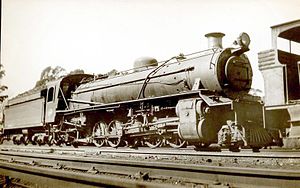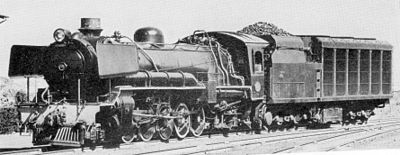SAR class 20
| SAR class 20 | |
|---|---|
|
SAR class 20
|
|
| Numbering: | 2485 |
| Number: | 1 |
| Manufacturer: | SAR |
| Year of construction (s): | 1935 |
| Retirement: | 1961 |
| Type : | 1'E1 'h2 |
| Gauge : | 1067 mm ( cape track ) |
| Length over coupling: | 20,752 mm |
| Service mass: | 74.5 t |
| Service mass with tender: | 126.2 t |
| Wheel set mass : | 11.9 t |
| Driving wheel diameter: | 1,219 mm |
| Cylinder diameter: | 533 mm |
| Piston stroke: | 610 mm |
| Boiler overpressure: | 137.8 N / cm² |
| Grate area: | 3.34 m² |
| Train brake: | Suction air brake |
The locomotive Class 20 of the South African Railways (SAR) was a steam locomotive with the wheel arrangement 1'E1 '( Santa Fe ). The unique piece with track number 2485 was built in the SAR workshops in 1935. The machine became known through its later conversion into a condensation locomotive .
Emergence
Class 20 was created with the intention of building a high-performance, but not articulated, locomotive with an axle load of 12 t. It was intended to be used in South West Africa , where relatively light rails were laid.
The locomotive was built in the SAR workshops in Pretoria and was a combination of various parts from other locomotives. The coupled wheel sets came from scrapped class 8 locomotives and the boiler from a class 19A machine , which in turn had received a new standard boiler . The cylinder blocks and the bar frame were newly manufactured, with the cylinders, apart from the reduced piston stroke, corresponding to those of class 19C and, like these, provided with a Caprotti valve control .
The locomotive was one of only four five-coupled tender locomotives in South Africa. The other three made up grades 18 and 21 .
The no. 2485 entered service in 1935. It turned out to be an extraordinarily successful construction, which was not challenged with the missions in South West Africa. So it was eventually stationed in Pretoria, where the locomotive could move adequate loads. The intended tasks in South West Africa were taken over by class 24 locomotives after the war .
modification
| Conversion to a condenser locomotive (different data) |
|
|---|---|
| Year of construction (s): | 1950 |
| Length over coupling: | 26,962 mm |
| Service mass: | 79.6 t |
| Service mass with tender: | 159.6 t |
| Wheel set mass : | 13.2 t |
Even before the Second World War, the SAR had become aware of the Henschel-Werke condensing locomotives that were being delivered to Argentina, the Soviet Union and Iraq . It was planned to convert a class 12A locomotive accordingly, but the war ended the plans and cut off contacts with Henschel.
At the end of the 1940s, the already tense water situation in the Karoo was exacerbated by a drought, and the SAR took up the idea of a condensation locomotive again. In 1948 it was decided to convert the class 20 locomotive, which had remained a one-off despite its good performance, to test the technology, and a condensing tender was ordered from Henschel.
This was based on an existing 2'3'T16 Kon. for the class 52 war locomotives. It was lengthened to accommodate the expansion of the cooling surface required for use under the climatic conditions in South and South West Africa, and it was given two three-axle bogies for Cape Gauge . Unlike the war locomotives, copper was used for the capacitors instead of steel. The tender was designed in such a way that it could have been used on class 20 and appropriately modified locomotives of classes 19D and 24 , which never happened.
The locomotive itself received an induced draft turbine, largely similar to that of the 52 Kon series. corresponded. The tender and its accessories arrived in South Africa in 1950, and No. 2485 was converted in the SAR's apprentice workshop in Pretoria.
The first trips took place in the middle of the year in the Transvaal . In 1951 test drives were carried out under extreme conditions (up to 40 ° C in the shade) in southwest Africa, as well as trips in the Karoo and in the eastern Transvaal. The tests resulted in a water saving of between 88 and 93% and a lower consumption of coal due to the feed water having a temperature of around 90 ° C after condensation. The range of the locomotive was between 650 and 1100 km, depending on the operating conditions. At the end of 1951, the locomotive was relocated to Touws River in the Karoo, further tested and occasionally also used in scheduled service.
The successful attempts led to the development of the much larger condensation locomotives of class 25 , which were introduced in 1953. In the same year No. 2485 was put into normal service in De Aar , from where it was used on the route to Windhoek . It remained in service until 1958 and was scrapped in 1961.
See also
literature
- Leith Paxton, David Bourne: Locomotives of the South African Railways. A Concise Guide. C. Strui (Pty) Ltd., Cape Town 1985, ISBN 0-86977-211-2 .
- John N. Middleton: Railways of Southern Africa. Locomotive guide. 5th edition. Beyer-Garratt Publications, Rickmansworth 1994, ISBN 0-620-18548-1 .

